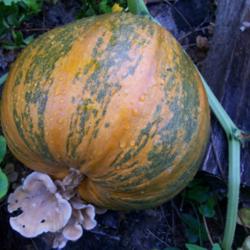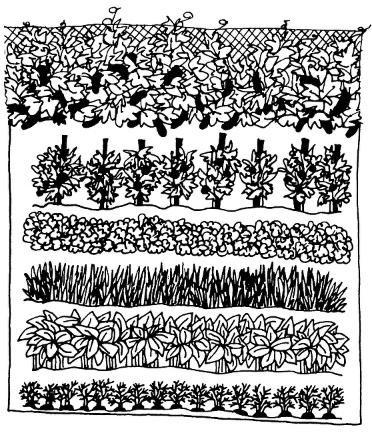
Before growing your vine crops, you may need to understand a little bit more about vine crop vernacular.
Seed Know-HowWhen it's time to choose seeds at the garden center or from a seed catalog, check with a gardening neighbor or your local cooperative extension service agent for advice on which varieties do best in your area. Seed companies have developed strains resistant to mildews, mosaic, scab, anthracnose and leaf spot, so you should look for disease-resistant varieties. These are indicated by capitalized letters on the seed packet or in the catalog. (SMR means scab and mosaic resistant, for example.)
It's also smart to start with seeds that have been treated with a powdery fungicide. The fungicide protects the seeds from rotting before they germinate and from damping off, when young seedlings just keel over and die.
Vine VocabularyBurpless - Thin-skinned varieties with a long, slender shape and no bitterness.
Cucurbits - The family of plants that includes cucumbers, melons, squashes, pumpkins and gourds.
Gynecious - Having only female flowers on the vine, requiring the presence of male flowers on an accompanying plant for pollination.
Hill - Group of plants or seeds usually arranged in a circle on level ground.
Monoecious- Having both male and female flowers on the same vine.
Mound - Raised soil used for planting in wet areas or in heavy clay soil; usually isolated to one crop or hill.
Netting - Criss-crossed pattern on the skin of muskmelons that becomes more and more pronounced as the fruit ripens.
Parthenocarpic - Seedless varieties that produce fruit without pollination. Because they produce only female flowers, they must be separated from other cucumber varieties. If parthenocarpic flowers are pollinated, the resulting fruits will be misshapened. Often grown as greenhouse cucumbers.
Ribbing - The series of contours along a melon, pumpkin or squashes outer skin. Some varieties have ribbing, some don't.
Slip - The crack that appears in a melon stem where it attaches to the fruit; indicates ripeness.
Spines - The wart-like bumps on gherkins and pickling cucumbers, which hold protective needles that deter pests.
Garden Planning
It seems to be a law of nature that the sweetest, juiciest garden vegetables are the ones that require the most pampering. To be rewarded with fine melons, for instance, you have to treat the plants as if they're on vacation -- lots of sun, water, food and warm weather. But if you treat them like royalty, they'll return the favor by producing delectable fruits.
Reserve a sunny, well-drained spot for your vine crops, preferably with a slight slope to the south. Sunny means at least six hours of full sun every day. The amount of space you allow depends on how many plants you and your family want, and whether or not you plan to support the vines with trellises or fences. If you've never grown vine crops before, it's best to start small. Cucumbers and summer squashes are especially heavy yielders. One hill per person in the household should be more than enough. If you intend to preserve or store much of the harvest, plant more.
To extend your harvest and avoid an overdose of ripe squash or cucumbers, grow two varieties, one that matures early and one that's later. Or, stagger your plantings for continual harvests and to avoid losing an entire crop if weather or disease problems hit.
Some varieties spread more than others. Keep this in mind as you plan your garden. If you plan to use supports, leave a walkway wide enough for you to cultivate by hand or machine. If you intend to let the vines run freely, beware -- some need lots of room. One good place to plant vine crops is at the edge of the garden, so the vines can spread over the lawn.

Wait to plant sensitive vine crops until after the average last frost date, unless you provide protection for them. Your local weather bureau can tell you when the average last frost date is expected, or ask an experienced gardener in your area. The surprising thing is that it's usually earlier than you think.
 Victory Seed Company has all the seeds you want for your best garden in 2024.
Victory Seed Company has all the seeds you want for your best garden in 2024.
For 25 years, the family-owned Victory Seed Company has provided the highest quality vegetable, herb and flower seeds to families across the country. We are passionate about providing you the best seeds available that give excellent germination, robust plants, and the harvest you want. With a catalog of over a thousand varieties, we have everything, and our prices are the kinds that we'd want to pay. We have hundreds of yesterday's heirloom vegetables, as well as today's award winning hybrid selections. Get to know us by visiting our website and browsing through our online vegetable seed catalog.
| 1. Getting Started with Vine Crops ← you're on this article right now |
| 2. Cucumber Varieties |
| 3. Getting to Know Squash |
| 4. Melon Varieties |
| 5. Pumpkin Varieties & Growing Big Ones |
| 6. How All Vine Crops Grow |
| 7. Ornamental and Unusual Gourds |
| 8. Cucumber Essentials |
| 9. Cross Pollinating Melons and Squash |
| 10. Melon Essentials |
| 11. Pumpkin Essentials |
| 1. Getting Started with Vine Crops ← you're on this article right now |
| 2. Cucumber Varieties |
| 3. Getting to Know Squash |
| 4. Melon Varieties |
| 5. Pumpkin Varieties & Growing Big Ones |
| 6. How All Vine Crops Grow |
| 7. Ornamental and Unusual Gourds |
| 8. Cucumber Essentials |
| 9. Cross Pollinating Melons and Squash |
| 10. Melon Essentials |
| 11. Pumpkin Essentials |